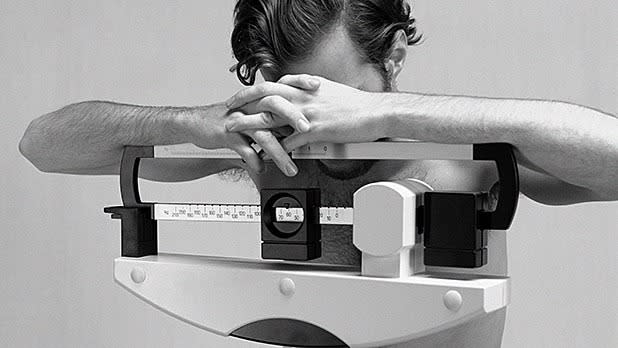How Much Should You Really Weigh?

(Photo Courtesy of Peter Dazeley / Getty Images)
The Center for Disease Control and Prevention estimates that 69 percent of the population is overweight or obese in the U.S. While it’s easy to point fingers at this problem, figuring out what you should weigh — for a healthy heart, and reduced risk of stroke, diabetes, and osteoarthritis — isn’t itself that straightforward. “The ideal body-weight calculations that the medical community uses is unrealistic for a lot of people for all these different reasons," says Marjorie Nolan Cohn, RD, spokesperson for the Academy of Nutrition and Dietetics.
How muscular a person is, bone density, where they carry weight, and genetics should all be figured into estimates of their ideal weight. But the most common measurement, Body Mass Index or BMI, doesn’t take any of this into account. While BMI is really easy to measure (just go to the government’s online calculator and plug in your height and weight), it doesn’t directly measure body fat or take account of bone and muscle.
Related: The Real Weight-Loss Workout
"A lot of athletes just based on weight versus height versus age may show up in the obese category, but clearly they’re not obese,” says Nolan Cohn. So, is your BMI accurate? We put together an informal test to give a sense of how well that number matches reality for you.
1. Measure your BMI and note where you are on the scale.
If you’re “underweight,” start with a -1.
If you’re “normal”, start with a 0.
If you’ve “overweight” start with a +1.
If you’re obese (and not a serious athlete*), you should probably stop here and see your doctor.
Related: The Truth About Healthy Obesity
2. Now, measure your hip-to-waist ratio.
Some experts actually put more stock into hip-to-waist ratio than BMI. This is because people who carry their weight in the middle are more likely to face adverse health problems, particularly cardiovascular issues.
To find your hip-to-waist ratio: Divide the circumference of the smallest part of your waist (usually above the belly button) by the largest area of your hips (probably over your butt).
If your ratio is less than 0.9, keep your score the same.
If it’s at 1.0 or higher, add 1 to your score.
3. Take your genes into account.
Arguing that someone is just naturally large tends to be met with disbelief, but there is no denying that genetics impact body composition. Yes, there are many people who carry more fat than they should for optimal health, but there are also people who are built to be larger. Nolan Cohn says she has a female client who was about 250 pounds who slimmed down to 170.
Related: 10 Reasons You Can’t Lose Your Gut
Based on this woman’s height, standard calculations would put her ideal weight around 130. "If her doctor didn’t know where she was, he’d tell here that she’s overweight now,“ says Nolan Cohn. However, this woman looks and feels great at her current weight and her blood work shows she is healthy. She is an example of someone who is structured differently than the average person.
Do you come from a big, healthy family? If so, subtract 1 from your score.
Are you much bigger than most of your family, or the same size but they have a fair amount of health problems? If either of these sound like you, add 1 to your score.
If you are skinny but come from a healthy, skinny family, add 1 to your score.
Related: How to Lose the Last 10 Pounds
*4. How athletic are you?
The approximate healthy weight range for a 5'10" man spans from about 129 pounds (if he has a slim build) up to around 183 pounds (if he has a large build). However, a competitive bodybuilder will usually weigh around 210 pounds at this same height but may reach 270 pounds. He would be obese by BMI standards because it couldn’t account for the fact that he is carrying so much muscle and so little fat.
Sumo wrestlers, who weigh upwards of 400 pounds, often live long, healthy lives, according to published research. It’s a similar story for linebackers, many of whom weigh over 300 pounds. Not only are they active, much of their weight is muscle rather than fat. Although their BMI would show these men are obese or even morbidly obese, they can still be medically healthy.
Do you lift weights ever day or have some serious muscle? Subtract 1 from your score
Run a lot? Keep it the same.
Couch potato? Add 1.
Related: Which Is Worse: Being Unfit or Being Fat?
5. Your Results
This test should be a practice that helps you understand the limitations of BMI and many factors that go into finding a healthy weight. In other words, do not make major health decisions based on this score. What the test should reveal is if you need to make life changes, and see your doctor in the process: If your final score is in the positive and you’re overweight (or near overweight) according to the BMI scale, you’re probably carrying more than is good for you — possibly a dangerous amount. If it’s negative and you’re underweight or near it, you should also be concerned as being underweight can also have severe health effects.
By Taylor Kubota
More from Men’s Journal:

